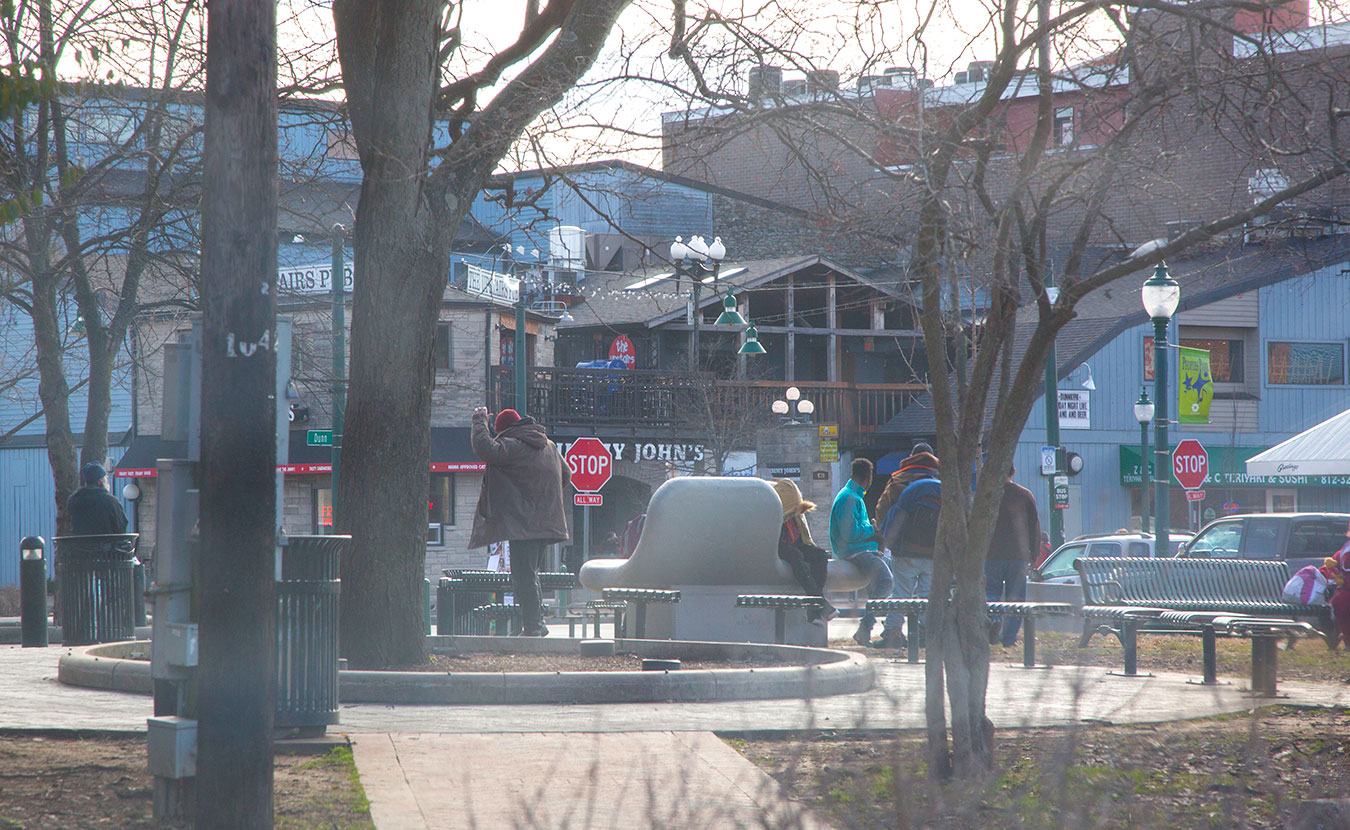Maybe you were just laid off, and, despite having a high school diploma, you live in a town flooded with overqualified college students snagging up all the minimum-wage jobs. Maybe you were in an abusive relationship, and you were either kicked out or you decided to finally leave.
Maybe you’ve struggled with your mental health your entire life, and that makes it difficult for you to keep a job or to go to school. Maybe, due to anxiety, depression, or past traumatic events, you’ve turned to drug use in a state where heroin addiction has skyrocketed over the past few years.
Maybe you were recently evicted from your apartment, because even though you work 40 hours a week, your minimum-wage job wasn’t enough to cut it in the town with the highest average rent in Indiana. Maybe you’ve been faced with a medical emergency, costing you what little money you had saved in your rainy-day fund.
Maybe you’ve worn out your welcome staying with friends and family, and you still haven’t been able to get back on your feet. Maybe you grew up in poverty, and this is the only life you know.
Regardless of how you got here, you got here. You are experiencing homelessness in Bloomington, a town known as a haven of social services. The Shalom Community Center, New Hope Family Shelter, and the Wheeler Mission Center are only a few of the many different local organizations offering services for people in need.
Despite these services, you don’t feel fortunate, and you know you won’t be looked at the same way you once were. Whether it’s a college student harassing you outside of a bar on Kirkwood Avenue, a restaurant owner kicking you off of their front porch, a city council member voting to enforce anti-panhandling laws, or someone creating petitions to remove people experiencing homelessness from Peoples Park — you will be stigmatized.
Forrest Gilmore, the executive director of the Shalom Center, says this stigma is not a minor issue.
“It kills people,” he says. “That prejudice kills people. Homeless people have an extraordinarily high rate of hate-based crime committed against them. One of the highest of any vulnerable group. I think it’s one of the last remaining acceptable prejudices.”
You may be homeless for the next few weeks, or for a year, or maybe you’ll face chronic homelessness for the rest of your life. There are many factors, both internal and external, that will influence which path of homelessness you will take. And that’s the important thing to remember: There is no one set path to homelessness.
So where do you begin?
7 a.m.
You slowly open your eyes, still tired, as if you hadn’t slept all night. If you’re lucky, you found a bed to sleep in.
If you were sober, you might have earned a spot at A Friend’s Place, Shalom’s overnight, high-barrier shelter. If not, and if you met other requirements, perhaps you woke up at a different shelter.
Or, if it’s between November 1 and March 31, you may have slept on a mat at one of the rotating Interfaith Winter Shelter locations. If it’s during the warmer months, you may have slept in a car, camped in the woods, afforded a hotel, or bundled up on the streets. On any given summer night, there are anywhere from 50 to 70 people Gilmore deems “street homeless.”
You don’t have much time to wake up and adjust to the morning, because it’s time to walk to Shalom. The day shelter provides two meals five days a week, with breakfast starting at 8 a.m. As a result, it is packed, both with volunteers and those looking for a meal.
“We’re the day shelter, and kind of the front door to a lot of the homeless services in our community,” Gilmore says. “We’re often the first stop for people.”
Though not everyone goes to Shalom for breakfast, you have learned this is the easiest route to take.
10 a.m.
If you chose to start your day at Shalom, you have access to several of their resources for the morning. You can use the shower facilities if you need to clean up or get warm. Laundry services are available if you need clean clothes for a job interview or if your clothes have gotten too dirty. Shalom offers mail services as well, in case family members need to reach you, or if you have a paycheck coming your way.
Using the services requires patience. With a high demand and a small supply of volunteers, lines pile up. If you need to use the phone to contact your doctor about updating your prescription, you’ll have to wait for someone to finish their phone call first. Tempers can run high.
“There’s a lot of waiting in homelessness, especially if you’re disabled,” Gilmore says. “Almost all of the long-term homeless individuals have some kind of severe disability. They usually have a lifetime of trauma, of generational poverty. Often, there’s mental health issues or severe mental illness and, quite commonly, an addiction issue on top of it.”
12 p.m.
It’s now lunchtime, and you’ve already learned a lot from the volunteers at Shalom and from others in your situation. If you scored a couple of bucks from panhandling, or if your paycheck came in, you may decide to go downtown to find something to eat. Your intuition tells you to eat the provided lunch at Shalom, but you know you’re bound to get sick of eating the same meals day after day.
Susan Grubb volunteers at Shalom. After spending all of 2016 homeless, she says you have to know where the free meals are, and you can’t be picky.
“If these guys here didn’t feed us, then we would never get food,” she says. “Because you only get fed so many times.”
Another reason you might stick around Shalom is to get in touch with other people experiencing homelessness. Gilmore says those in the homeless population learn a lot from each other, whether it’s information on different shelters, tips on where to get meals, how to successfully panhandle, promising job offers, or even information about possible landlords who may rent out to formerly homeless individuals.
Unfortunately, he says, this is also how word spreads about alcohol and drug hookups.
4 p.m.
By now, if you haven’t left already, Shalom is closing its doors for the day. Although the sun is still out, you have to start thinking about where you’re going to sleep tonight.
A Friend’s Place opens first-come, first-served at 5:15. You can try finding shelter at Wheeler’s separate overnight shelters for men and women, but they’re both a hike from downtown. Even New Hope, which has overnight services, is often booked a month in advance. Your sobriety, your gender, and whether or not your family is with you will determine which shelter you qualify for.
Because of these limitations, many are unable or choose not to stay in overnight shelters. Debra Morrow, the community programs director at Middle Way House, says this has caused a gap in coverage.
“There’s a lot of good services out in the community, but there’s so many people, and somehow we’re not reaching all of them,” she says. “The need is so great in our community, and it’s heartbreaking.”
While the demands are high, these organizations try their best to make sure people have a full meal and a place to sleep. Community Kitchen of Monroe County serves meals Monday through Saturday from 4 to 6 p.m. “Anyone who comes into the kitchen during that time gets a full meal,” says Tim Clougher, assistant director of Community Kitchen. Not only does Community Kitchen provide food to people staying at A Friends Place every evening the kitchen is open, it also offers carryout meals at their Express location on West 11th Street each night from 4 to 6 p.m. “Folks can take meals with them and eat when and where they would like to,” Clougher says. “Reheatable meals are also passed out at our Rogers Street location.”
9 p.m.
If all else fails, and if it’s during the right time of year, your best bet is to stay at the Interfaith Winter Shelter. Alternating between First United Methodist Church, First United Church, Trinity Episcopal Church, First Christian Church, and Wheeler Mission Bloomington, Interfaith Winter Shelter provides light meals and mats for the night.
While the Interfaith Winter Shelter is low-barrier, with the only criterion for admission being respectful behavior, spots are limited and transportation can be difficult. With Wheeler and First United Church being so far from downtown (on the west side and east side, respectively), it proves difficult to find transportation or to make it there on foot in time.
Grubb says when she was experiencing homelessness, she often had to spend her time walking between shelters. “Sometimes we have to walk the streets, and walk and walk until it’s time to go in,” she says. “And sometimes, if you don’t get in a shelter in time, you’re stuck out here all night.”
The next day
If you’re lucky, one of the shelters had a spot for you, at least for the night. Tonight, your luck may fall short. Or tomorrow. Or the day after that.
Tackling homelessness one day at a time may temporarily solve the issue of surviving for the night, but Elaine Guinn, the executive director of New Hope Family Shelter, says this tactic is exhausting and fleeting.
“I’m trying to stop thinking so temporarily as one night,” she says. “Because one night just perpetuates a revolving door of crisis. How can you ever really start to move forward if you’re in that? A single night of shelter might be necessary, but it’s part of the problem as well.”
[Editor’s note: In Part 2 of Paths of Homelessness, TJ Jaeger looks into the stigma that those experiencing homelessness face every day, as well as tactics used by local organizations in the attempt to end chronic homelessness in Bloomington.]







No Replies to "Paths of Homelessness, Part 1: Your First Day"